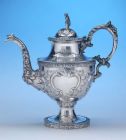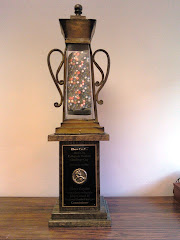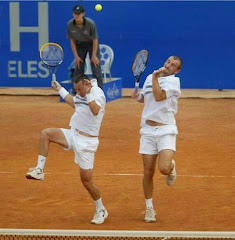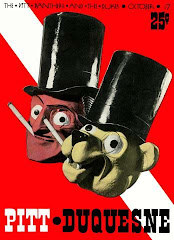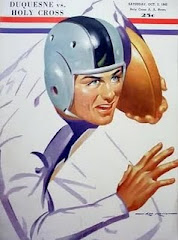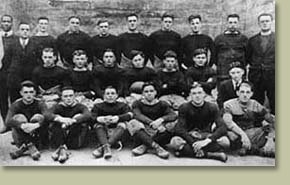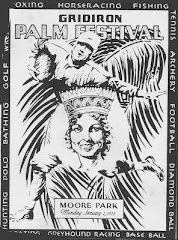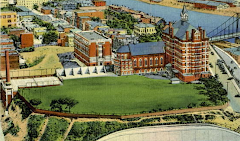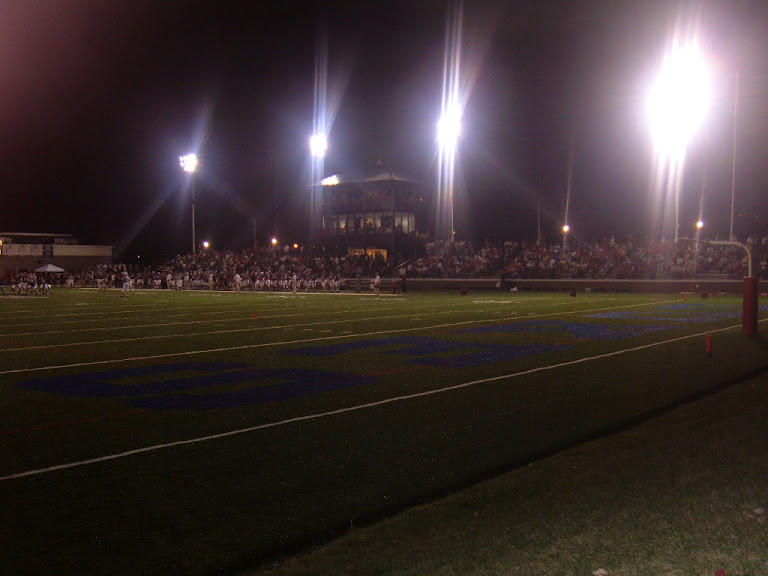Saturday, November 19, 2011
DUKES DRUB ROBERT MORRIS 45-10: EARN NEC CONFERENCE CO-CHAMPIONSHIP
The Duquesne Dukes ended the 2011 season with a convincing 45-10 blow out over their cross-town rival Robert Morris Colonials. As the game wound down and it became clear that the Colonials had no answers for Patterson, Dixon, Williams and Oliver, there seemed to be more interest in the score of the game being played a few hundred miles to the Northeast.
Aside from the last quarter of the Bucknell game and the first quarter of the Albany game, the Dukes have completed a masterful 9-2 season. The game was typical of the rest of the season as Sean Patterson found Conner Dixon for three touchdowns, Larry McCoy ran for another hundred yard game and a touchdown the defense closed out the opposition allowing only 10 points.
The Dukes tie for the NEC Conference Championship but miss a trip to the NCAA Playoffs as Albany beat Sacred Hear 31-21. Honestly, this is a Duquesne team that would stand a very good chance to win a game or two in the NCAA Tournament.
More post game coverage to come tomorrow. I know that the 2011 Edition of the Duquesne Dukes deserve an Honorable Mention as one of the best Duquesne Football teams ever (See below right). I have a tough decision to make if they bump into the Top 20 Teams ever replacing the 1942 team that was ranked # 13 in the nation by th AP during their seson. Let me know what you think at the Forum.
From the NEC Web Site:
The race for the 2011 Northeast Conference football crown came down to the final day of the regular season on Saturday, and in the end, Albany and Duquesne each staked its claim to the title. The Great Danes and Dukes both finished 7-1 in league play on the year, but it was Albany which earned the NEC's automatic bid to the NCAA FCS playoffs by virtue of its head-to-head victory over Duquesne in early October. UA will learns its NCAA opponent when the 20-team playoff bracket is announced Sunday at 10:00 am live on ESPNU.
Friday, November 18, 2011
Steel City Bragging Rights: Duquesne Robert Morris Preview/Prediction
The visitors come in with 8 different starting lineups against a home team that pretty much has been steady with even a few upgrades with the addition of another year for Conner Dixon and the addition of a projected starter for Ohio state, Dorian Bell to an already deep defense.
Finally, the Dukes are playing to preserve a chance to make the NCAA Playoffs with some cooperation from the Albany Sacred Heart game while the Colonials are just trying to salvage a bit of pride in a season after they themselves won the playoff spot.
After all this, can the Colonials come in and take this game? Certainly. After all, the Dukes outplayed and still lost to Bucknell and this is a "rivalry" game.
Will they?
No- Dukes 31 RMU 17.
CAUTION: The Dukes have to remember that a win for the Colonials will salvage their season. They can not let up as they did against a Bucknell Bison team that they outplayed but lost to at the beginning end of this season.
Monday, November 14, 2011
Dukes Pound, Now Pull for Pioneers
After beating Sacred Heart 29-15, the Dukes will be pulling for them to win this week as the Pioneers visit Albany. Although the Dukes are tied with Albany with 6-1 Conference records, the Great Danes win the tie breaker with a head to head win against Duquesne even though the Dukes own a better overall record at 8-2 vs Albany’s 7-3. The conference winner gets an automatic bid to the NCAA FCS Tournament.
The Dukes have to take care of business against cross town rival and last year’s NEC Champion, Robert Morris. While the Dukes have more than lived up to pre-season billing as one of the top teams in the conference, the Colonials enter this rivalry game with the Dukes at a disappointing 2-5, 2-8 record.
Even if the Pioneers are unable to upset the heavily favored Great Danes at Albany, the Dukes have quietly built an impressive season after a game they should have been able to hold on to win at Bucknell to open the season.
This team has certainly closed the scholarship gap with the rest of the NEC and legitimately has readjusted its goals from merely being competitive to wanting the top spot in the conference. No matter how the conference race ends up at the end of the day on Saturday, local college football fans and media need to wake up and realize that they have another winner in this town. I’d like their chances better this year against teams such as Delaware. The same Delaware that will be playing Pitt twice in the next few seasons.
Sunday, November 13, 2011
Away for the weekend
Saturday, November 5, 2011
WAY TO GO BULLDOGS!!
Send a sack of bones to the Bryant... The Bulldogs won the dog fight with the Great Danes at Albany 31-17. Dukes have to win out and hope Albany loses one to either at Monmouth or to Sacred Heart.
Headline From the Duquesne Football Archives:

1942 Milwaukee Journal claims city football dominance over Pitt before WW II program cut.
Looking Back 120 Years and Looking Ahead

1937 Duquesne Orange Bowl Victory over Mississippi State
What was the first collegiate team on record to play Duquesne? (Duquesne was known back then as Pittsburgh College of the Holy Ghost)

The Layden Trophy- 3 Feet Tall- Bronze, glass and real oak.
“For all the Marbles” in the Steel City
The Pittsburgh Coaching Legends Trophy will not be the first award offered to recognize the winner of local college football contests. In December of 1936, The Pittsburgh City Council authorized Mayor Cornelius D. Scully to award a Championship Cup not to exceed $2000 in cost to Duquesne as the top collegiate football program in the city that year. That year, the Dukes went on to win the Orange Bowl in Miami as well. The cup was presented each year until one of the three universities could win it three consecutive years, claiming permanent ownership of the cup. It would be interesting to know if either trophy still exists in a dusty trophy case somewhere on the campuses of Pitt, Duquesne, or CMU.
Pitt and Carnegie Tech had a still earlier similar cup awarded by the city until Pitt was able to win three years in a row, claiming ownership. Technically, Pitt and Carnegie Mellon could still play for the Layden Cup but it is unlikely in the near future given the differences in their assigned collegiate NCAA Divisions. At present, Duquesne and Robert Morris are the only two teams likely to play for the Cup although Pitt does usually play an FCS opponent each year.
I would like to offer the cup to the Heinz History Center’s Sports Museum to house and perhaps set up a small display recording all of the times the local teams went head to head against each other.
The Layden Cup
The games began with the first in 1901 between Duquesne (then the Pittsburg College of the Holy Ghost)and Pitt (then known as the Western University of Pennsylvania). Between Pitt (29 wins), CMU [originally Carnegie Tech] (18 wins), Duquesne (15 wins) and RMU (5 wins), I need 29 gold marbles, 18 red marbles, 15 or more blue marbles and 5 or more white marbles along with 2 clear marbles to represent the two ties. Overall there have been 69 games played in head to head Steel City College Football. This year's game allows either Duquesne or RMU to add the 70th marble.
One problem- I need help to find these marbles and my wife will shoot me if I spend any more on the trophy. Is anybody able to help? There will soon be a picture of the cup here on this blog when the face plate is added. There already are some articles from the past below as the idea of a Steel City Challenge Cup developed.
Alternate colors to represent the teams could be Pitt (gold), Duquesne (red), CMU (white) and RMU (blue).
The Elmer Layden Cup Steel City Collegiate Football Challenge Cup
Elmer Layden was the first Duquesne coach to play both Pitt and Carnegie Tech (Later Carnegie-Mellon). Layden had been one of Grantland' Rice's famed Four Horsemen of Notre Dame and later went on to become the NFL's first commissioner. The Dukes would win their first New Years Day game under Layden, the 1934 Festival of Palms Bowl. The bowl was re-named the Orange Bowl the following year. Duquesne would win the Orange Bowl again later that decade.
Past winners of head to head Pittsburgh Rivalry games are listed below.
1901- Pitt over Duquesne 18-0
1903- Duquesne over Pitt 10-6
1910- Pitt over Carnegie Tech 35-0
1923- Carnegie Tech over Pitt 7-2
1924- Carnegie Tech over Pitt 6-0
1925- Pitt over Carnegie Tech 12-0
1931- Duquesne tied Carnegie Tech 0-0
1932- Pitt over Carnegie Tech 6-0
Pitt over Duquesne 33-0
1933- Pitt over Duquesne 7-0
1934- Carnegie Tech over Duquesne 3-0
1935- Duquesne over Carnegie Tech, 7-0
1936- Duquesne over Pitt 7-0
Duquesne over Carnegie Tech 13-0
1937- Pitt over Carnegie Tech 25-14
Pitt over Duquesne 6-0
Carnegie Tech over Duquesne 6-0
1938- Carnegie Tech over Duquesne 21-0
Pitt over Duquesne 27-0
1939- Duquesne over Pitt 21-13 (Last Pitt-Duquesne)
Duquesne over Carnegie Tech 22-7
1940- Duquesne over Carnegie Tech 14-7
Pitt over Carnegie Tech, 6-0
1941- Pitt over Carnegie Tech, 27-0 (Last Pitt-Carnegie Tech)
1980- CMU over Duquesne 39-7
1981- Duquesne over CMU 27-10
1982- CMU over Duquesne 19-0
1983- CMU over Duquesne 14-11
1984- CMU over Duquesne 20-14
1985- CMU over Duquesne 31-10
1986- CMU over Duquesne 33-22
1987- CMU over Duquesne 17-13
1988- CMU over Duquesne 24-14
1989- Duquesne over CMU 11-10
1990- CMU over Duquesne 31-8
1991- CMU over Duquesne 28-14
1994- Robert Morris over Duquesne 28-6
1995- Robert Morris over Duquesne 38-20
1996- Robert Morris over Duquesne 28-26 (ECAC Bowl)
1998- Duquesne over Robert Morris 24-22
2003- Duquesne over Robert Morris 33-28
2004- Robert Morris over Duquesne 34-14
2005- Duquesne over Robert Morris 23-12
2006- Duquesne over Robert Morris 27-7
2007- Duquesne over Robert Morris 17-14
2008- Robert Morris over Duquesne 34-27
2009- Duquesne over Robert Morris 34-20
2010- Robert Morris over Duquesne 34-11
2011- Duquesne over Robert Morris 45-10
2012- Robert Morris over Duquesne 18-13
2013- Duquesne over Robert Morris 21-10
2014- Duquesne over Robert Morris 22-0
2015- Duquesne over Robert Morris 16-7
2016- Duquesne over Robert Morris 31-24
2017- Duquesne over Robert Morris 51-14
STEEL CITY FOOTBALL RIVALRIES
It was in 1901 that that Pitt, then known as Western University of PA, would win the first recorded contest between Steel City teams with a 18-0 win over Duquesne. Duquesne was known at the Pittsburgh Catholic College of the Holy Ghost until 1911. Duquesne or PCC/HG returned the favor in 1903, beating Pitt 10-6. In 1906 Pitt beat up on Carnegie Tech 35-0. Tech got revenge in the next game, but had to wait 17 years in 1923 by a score of 7-2. Duquesne’s teams reached prominence under coach and former Notre Dame Four Horseman, Elmer Layden. One of their standout early players was Steeler founder and namesake of Rooney Field, Art Rooney Sr.. Art Sr. was their quarterback and place kicker in the 1920’s. It took Duquesne’s 41st year after starting a program to play in an inter-city game with Carnegie Tech, drawing 0-0 in a charity game in 1931.
The Pittsburgh college football rivalries took off BIG TIME after that. All three teams, Pitt, Duquesne and Carnegie Tech, were ranked often in the first national college football rankings put out by the Associated Press.
As the teams became better, the rivalries became bitter. All three teams played nationally known opponents including Notre Dame and the then powerful service academies. But they often faced more determined battles in their own back yards. Pitt, Duquesne and Carnegie-Tech all played in New Year’s Day Bowls, but National Championships were up for grabs when they met during their regular season. Back then only the very top teams played in the Rose, Orange (First known as the Festival of Palms Bowl) and Cotton Bowls. There were no Outback Bowls or the dozens of other modern bowls that cheapen the achievement today.
The college game and its rivalries actually dominated local sports to a point where the same Art Rooney had to take the Steelers on the road to places like Johnstown, Louisville, and New Orleans to sell tickets.
Unfortunately the rivalry between Pitt and Duquesne ended in 1939 with a Pitt loss to the Dukes. Pitt was ranked #1 in the nation by the AP going into the game. The Dukes went on to an undefeated season that year and finished in the AP Top Ten and #1 in the Massey Ratings (See article below). The last game of the great city rivalry came in 1943 when Pitt also ended their series with Carnegie Tech, beating the Tartans handily 45-6. By then, Duquesne had folded its team for World War II and only briefly tried again after the war. Pitt’s rivalries then turned to Penn State and today’s Backyard Brawl with West Virginia.
The Pittsburgh collegiate rivalry lay dormant for decades until Duquesne’s club football team stepped up to Division III and re-ignited their rivalry with the Tartans of Carnegie Mellon. CMU and Duquesne played spirited games from 1980 to 1991 at times even at Three Rivers Stadium. When Duquesne stepped up again to 1-AA, the Steel City Rivalries ended again.
It didn’t end for long. A new collegiate team would be founded a century after Pitt and Duquesne began theirs in Pittsburgh. Robert Morris started from scratch under the direction of former NFL head coach Joe Walton. Duquesne’s series with the Colonials began in 1994 with the Dukes holding a slight edge 5-4. Both teams were consistently ranked at or near the top of non-scholarship 1-AA football. Now, both teams are stepping up in talent when the NEC member Robert Morris began offering scholarships three years ago. Duquesne offered its first scholarship since 1950 when it joined the Northeast Conference this year.
And so, with both teams now in the same conference and stepping up in competition, the Steel City Football Rivalry is on again.
MAJOR COLLEGE FOOTBALL 1941: THE DUKES WERE # 1 !
http://www.masseyratings.com/cf/years.txt
More About Duquesne and Major College Football Rankings
Many recognized collegiate football ranking systems begin declaring national champions dating back to 1869 when Princeton was declared national champion by most systems. Controversy exists even in that year’s selection of the nation’s best by some systems rating Rutgers at the top. Back then there were no polls taken by sports writers such as the AP Top 25 or the USA Today Poll or the now defunct UPI Coaches Poll.
The most familiar and accepted current system, The Associated Press only released their first collegiate football ranking in 1934. No AP Poll was released in 1935 but they have been releasing continuous rankings since 1936. The only inconsistency with the AP Poll since 1936 relates to the years when they would not issue a final yearly ranking after the college bowl games.
College football teams from 1869 to the present are ranked very accurately and without regional prejudices by statistically based systems such as the Sagarin, Massey, Sorrenson, RPI, Dunkle and other computer models. Most of these commonly accepted and statistically sound models are fairly consistent since they all basically look at a teams record against their strength of schedule. Their formulas as to how to factor in data from when in the year a team lost or home field advantage do rate teams differently.
Thus, even when bias from a sports writer, coach, or fan is not considered, there is seldom a year when all agree as to who is the nation’s best college football team. Even then, who is to say the fans, coaches and writers shouldn’t have a say over cold computer calculations.
The current BCS System makes an effort to achieve some consensus by relying on both polling data and computer ranking systems. Obviously, even the BCS Series Rankings has never made all of the people happy all of the time.
This debate and controversy over whose team is the best is really part of what being a college football fan is all about.
Duquesne’s National Major Football Championship
All this being said, there was a time and respected system that has declared the Duquesne Dukes the National Champion. That honor belongs to the undefeated and untied 1941 edition of the Duquesne Dukes. This rating is no fluke. The ’41 Dukes gave up only 21 points all season and were led the nation in scoring defense, rushing defense and total defense. No major college team since has given up fewer points.
Only Duquesne, Minnesota and Duke finished the 1941 season undefeated and untied among major programs. Admittedly, Minnesota has been recognized by most ranking systems, including the AP as being the # 1 team in the nation that year. However the Massey Rating System has looked at the data and declares Duquesne to be the #1 team in the nation that year. Duquesne was considered to play in the Cotton Bowl that year. Had they been selected and gone on to beat Texas A & M they would have had a good claim over Minnesota.
The Massey System.
The first questions that most would ask are what is the Massey system and is it legitimate? It is legitimate to the point that the current BCS Series currently uses it to determine which teams are selected to play in the BCS Bowls and for the National Championship. The Massey Ratings may be the most scientific and full-featured system available.
Kenneth Massey has been doing these ratings since 1995 and offers previous ratings back to 1930 based upon available data. Massey’s system takes no short cuts. For example, most ratings give a standard home field advantage factor of about 4 points to all home teams. Massey makes the home field advantage factor more precise by analyzing each team’s performance at home vs. away and neutral site games to determine a more accurate facet in rating teams. In other words, winning at home doesn’t and shouldn’t have the same degree of advantage for all teams rated.
The Massey Ratings are also thought to be considerably accurate when considering strength of schedule. This is no easy task when considering the college football world of 1941 when the best in the country often still played considerably lesser-developed programs.
National Major College Football Classifications and Ratings
Duquesne’s first team was fielded in 1891. As most other college teams of the era, the original Dukes’ opponents were not necessarily from other colleges. They included athletic clubs and even high school teams. Nor were there restrictions that all team members had to be current or former students. This began to change as the Intercollegiate Athletic Association of the United States (IAAUS), was established on March 31, 1906 to set rules for college athletics. The IAAUS became the National Collegiate Athletic Association in 1910.
Prior to 1937, ranking colleges was difficult since programs varied widely as to the class of opponents each school would play. Going undefeated against a schedule that included Notre Dame, Penn State and Michigan was obviously more impressive than one that included lesser opponents. With the advent of Bowl selections, the college football had to start separating the apples from the oranges.
In 1937 the NCAA began issuing a system that divided its collegiate football programs into Divisions and placed restrictions on how often teams from each division could play each other. In 1937, the top division was the “University” or “Major College” Division. In 1973, The NCAA restructured its classifications to rename the major programs “Division I”. Division I was subdivided into “I-A” and “1-AA” in 1978. Currently, Duquesne plays in Division I-AA or as the NCAA now officially calls it the “Championship” Subdivision of Division I vs. the “Bowl” Subdivision. Other current NCAA Divisions are II and III. The NAIA and the NCCAA govern smaller college athletic programs.
Massey considered all 119 NCAA Major College football programs when he ranked Duquesne # 1 in 1941. (See link at- http://www.masseyratings.com/cf/years.txt )
Duquesne’s Past Collegiate Classifications
Until the NCAA began to define the caliber of competition, Duquesne was considered an “Independent” collegiate football team along with all other college teams. When the University or Major Division was established in 1937, Duquesne was among this group of just over 100 other colleges and universities. Massey’s 1941 rating considered 119 Major Division teams when it selected Duquesne # 1 in the nation.
Unfortunately, just as Duquesne Football was reaching its highest potential nationally, the team was cut by the University due to the Second World War. Both the AP and Massey had ranked Duquesne teams throughout the 30’s and 40’s prior to the war. Massey ranks the 1933 Dukes at #8 and the 1936 Dukes # 2 in the nation. The AP ranks them at # 14 and # 8 respectively.
Duquesne briefly tried to re-establish the team after the war as a Major Division program, but gave up after the 1950 season. Students and volunteers would start Duquesne’s next team as a club.
Duquesne’s Other National Collegiate Football Championships
When Duquesne re-started its football program in 1969 as a club team, it was sanctioned by the now defunct NCFA. Duquesne was recognized as the National Club Champions in 1973 when they went 10 – 0 under coach Dan McCann and defeated Mattatuck 13-7 in the National Championship game played Three Rivers Stadium.
In 1979, the University again took over sponsorship of the program as an NCAA Division III program. Interestingly, Division III would be the only classification where Duquesne Football could not claim a national championship rating or ranking.
The program would be “upgraded” again in 1993 when it would move to the NCAA Division I-AA. However, the move to I-AA did not necessarily mean that the Dukes would be able to compete on even terms with most other I-AA programs since they would join an odd group of schools who were considered I-AA, but would not be allowed to award scholarships and would have severe limitations on the amount of money they could spend on travel or coaching staffs. This “cost containment” approach to keeping the university at the NCAA Division I for the rest of the school’s athletic programs would evolve into a strange subdivision within the I-AA subdivision known at the “Mid-Majors”.
The Sports Network (TSN) and Don Hansen’s Weekly Football Gazette both developed a bit of love for this odd group of so-called major programs who would not or could not commit the resources to compete with the other major programs of Division I-A and I-AA. Generally, there were about 30 college programs that would either play as independents or populate the Metro-Atlantic Athletic Conference, the Northeast Conference and the Pioneer Conference. All three were officially recognized by the NCAA as belonging to the I-AA Division, but were not given automatic berths to the I-AA Playoffs.
Duquesne would come as close as any of the Mid-Majors to competing with their better-funded I-AA brothers. Greg Gatuso’s squad often played scholarship programs and often won. Not only were these Duquesne team often ranked # 1 by the TSN and Hansen Polls, but were often ranked in the regular I-AA polls. Their highest ranking in the National I-AA Coaches Poll was # 14 before losing their only game of the 2002 season to Albany in the ECAC Classic. Both the TSN and Hansen rankings would select the Dukes the following years as the # 1 Mid-Major National Champions in 2003 when they beat Monmouth to win that year’s ECAC Classic.
Now the “Mid-Majors” are no more. Duquesne and most of the other Mid-Majors have either begun to offer scholarships or have folded.
The Dukes have laid at least partial claim to National Football Championships from the Club level to the I-AA Mid-Majors to, according to the Massey Ratings, the Major College level. What does the future hold for the Dukes at the regular I-AA level now that they have begun to award scholarships? The NEC, the Duke’s new conference will be eligible for a bid to the Division I-AA National Championship beginning in 2010.
The 1941 Massey Ratings
1941 Teams Rated: 119
Team W L T PF PA Off Def Sched Rating Dom
1 Duquesne 8 0 0 17.88 2.62 4 2 44 33.84 0.736
2 Minnesota 8 0 0 23.25 4.75 5 4 41 29.26 0.609
3 Mississippi St 8 1 1 19.10 5.50 28 1 4 26.63 0.530
4 Notre Dame 8 0 1 21.00 7.11 6 11 49 26.20 0.517
5 Alabama 9 2 0 23.91 7.73 8 8 5 26.09 0.514
6 Georgia 9 1 1 29.00 7.73 3 26 28 23.63 0.440
7 Texas 8 1 1 33.80 5.50 1 36 38 23.50 0.436
8 Oregon St 8 2 0 14.30 4.90 23 3 30 23.21 0.427
9 Michigan 6 1 1 18.38 5.12 17 6 22 22.32 0.401
10 Navy 7 1 1 21.33 3.78 16 7 34 21.97 0.390
Filling In Duquesne's Football Tradition: The Real Record
For example, how many times did Duquesne play Pitt on the football field and what was their record? Duquesne's media guide lists the record at 2-4 with the recognized games being in the 1930's when Duquesne and Pitt were both nationally ranked powers.
Pitt's football records are a bit more complete and show that the first Pitt-Duquesne game turned out to be an 18-0 Pitt victory over the Dukes in 1901. However, the Panthers don't recognize a loss to Duquesne in 1903 by a score of 10-6.
Part of the reason for the confusion could be that Pitt, at the time of both earlier games was known as the Western University of Pennsylvania and Duquesne was officially known as the Pittsburgh College of the Holy Ghost.
Instead of Duquesne's Media Guide record of 2-4 and Pitt's version of 2-5, the actual record is 3-5. This record is now verified by the College Football Data Warehouse.
By cross checking available records from Pitt, West Virginia, Washington and Jefferson, I.U.P., Thiel, Westminster, St. Francis, Geneva, University of Buffalo, Bethany, California University of PA and others, Duquesne's documantable all time record should stand at 395 wins, 287 losses and 25 ties.
Duquesne's Media guide does not include a proud 1891-1901, first decade record of 33-17-5 in its all time record. It does, however, now list Duquesne's first documented collegiate game, a 1893 loss to Washington and Jefferson by a score of 22-19.
It would be a great recognition of a proud football tradition to claim our 400th win if it occurs this year!
1937 Duquesne Orange Bowl Win
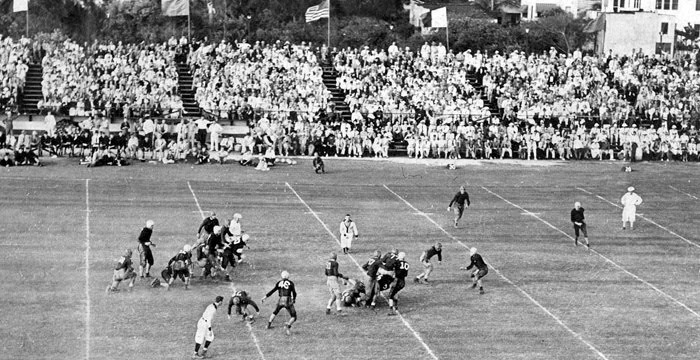
Dukes beat Mississippi State 13-12
DUQUESNE UNIVERSITY TRIVIA

Chatham Square used to be named Tunnel Street, but it wasn't named after The Armstrong Tunnels. It was named after a still existing, sealed off tunnel that carried the old Pennsylvania Canal under the lower hill between a basin near Penn Station and emerging in front of where the Armstrong Tunnels are now. From there the canal barges followed the old re-vamped Suke's Run basin to debauch into the Monongehela River near the base of the Panhandle Subway Bridge (Roughly behind Fisher Hall, crossing Boyd St. and then between Rockwell Hall and the Building just bought from Robert Morris and from there into the Mon). Picture shows the Pennsylvania Canal Tunnel, left and the Panhandle RR Tunnel, right during construction of the USX Tower.
Duquesne Broadcast Crew on WMNY 1360 AM

ALEX PANORMIOS (right) In his 16th season as play-by-play "Voice" of the Duquesne Dukes. He is the founder and president of Red Zone Media, Inc., an internet company that specializes in streaming high school and college sporting events since 2000. He also serves as the play-by-play voice of the Duquesne women's basketball team. Alex, his wife Mimi and son Alex reside in the North Hills of Pittsburgh. TAD MAUREY (left) Color Commentary. Tad is in his fourth season at Color of the Dukes football team and his 10th in the same position for the Women’s Basketball team. Tad hosts the Suzie McConnell-Serio Radio show during the women’s basketball season. Tad currently resides in Oakmont Borough. RYAN GAVATORTA (not pictured) serves as studio host of the games at WMNY provides weekly coverage of all Duquesne Athletics before and after the games. (Picture and bios courtesy WMNY)
1929 Dukes at White House with President Hoover

5th best All-Time Dukes Team went 9-0-1. Pre-AP Rankings. Only blemish was a 7-7 tie with West Virginia. Moved from campus "Bluff Field" to Forbes Field. First night games ever in Pittsburgh. Coach Elmer Layden. Hoover would face the beginning of the Great Depression later that same year.
TEN REASONS TO ADD MORE SEATS TO ROONEY
2. Scheduling- It will be very hard to attract quality out-of-conference opponents to Rooney Field. Even the soccer teams that come in think the field looks “quaint” to be polite.
3. Attendance- I’ve brought along friends to see a game at Rooney and it really doesn’t feel like a real college game atmosphere. They enjoyed the game, but would be more likely to come back if there was more atmosphere.
4. Crowd Noise/Emotion- Emotion feeds emotion. It is extremely difficult to get a crowd into the game with so few rows behind you.
5. Home Field Advantage- This crowd noise obviously help the home team.
6. Financial Benefit- It would be easier to charge admission to build a revenue base. Football needs to be a moneymaker for the rest of the department (or at least support itself) as it does for many other colleges. Too many fans, particularly from the opponent’s side of the field are just walking up without paying. A better field will also attract more paying customers and also could be a chance for student groups to set up booths as they do at other universities.
7. Press Coverage- If given a choice between covering a game at other college with a lower or same classification, but a better field facility, we are not competitive. TV highlights from games at Rooney look small time.
8. Hosting Games- Central Catholic actually decided to hold its games elsewhere due to the lack of seating capacity. This is a good school to keep associated with.
9. Academic Excellence- Who knows how many students come on campus to consider Duquesne when Central Catholic plays here or when they take a campus tour or if they come to see a Dukes game and get the feel of a real college game? The students we want to attend Duquesne are those with school spirit who want to picture themselves as being part of something fun and exciting. Rooney’s size does not paint this picture.
10. School Pride- This field just looks small time in comparison to other local fields such as Walton Stadium.
DUQUESNE-RMU TROPHY
|
Duquesne University Fight Song-Rev. Thomas Quigley 1926
We'll sing hooray for the Red and Blue,
A big hooray for the Red and Blue;
For the flag we love on to victory,
And when the foe is down,
we will raise a mighty shout
And sing hooray for the Red and Blue;
We're all your sons and daughters true.
Now with all your might, give them
fight,fight, fight
for the grand old Red and Blue.
DUQUESNE DUKES ALL-TIME FOOTBALL RECORD (1891-2011)*
Winning %- .574
~DUQUESNE GLORY/GORY YEARS~
Unbeaten 1929 Dukes at the White House with the President
5th best All-Time Dukes Team went 9-0-1. Pre-AP Rankings. Only blemish was a 7-7 tie with West Virginia. Moved from campus "Bluff Field" to Forbes Field. First night games ever in Pittsburgh. Coach Elmer Layden. Hoover would face the beginning of the Great Depression later that same year.

This site and material are the property of Mark Draskovich (Coffee)©
Popular Posts
-
The Colonials proved that they are for real at Joe Walton Stadium, dropping their cross-town rivals the Duquesne Dukes 34-11. The Duquesne ...
-
One of the most precious gifts I had ever received from my father-in-law (aside from my wife of course) is a vivid memory of his he shared o...
-
My laptop died this morning, but thanks to "Curious" from the Football Forum, we have a pretty good wrap-up. The Dukes got two to...
-
I know that Duquesne has had a history of holding its own as it is "playing up" against programs with better facilities and higher...
-
It's time to do our part... The La Salle game was absolutely one of the best games I've ever seen at the Palumbo. I saw a lo...
-
July 22, 2011 Duquesne University will officially dedicate The Keller Fieldhouse at Rooney Field on Saturday, August 6. A ribbon-cutting ...
-
The box score reads that the Delaware Blue Hens beat the Duquesne Dukes 30-6. Sometimes the final score is not the most important outcome ...
-
Can there be a “bright side” to a 55-10 blowout? After waiting a few hours and looking over the game stats, the answer actually may be “yes...
-
I recently discovered how the renewed production of Duquesne Beer ended the 30 year curse on Duquesne Basketball. Duquesne Beer was produce...
-
I have been running the Duquesne Football Forum and Blog for a while now and I can't ever recall having more interaction between our fan...

















